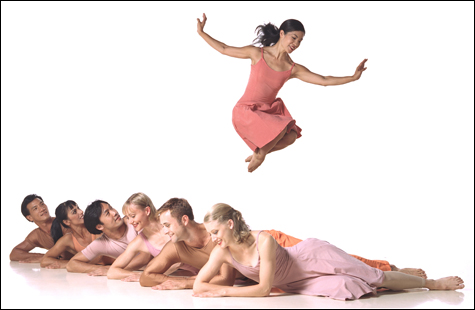
ESPLANADE: Taylor 1975 piece has evolved into a bouncy, almost slapstick company rout. |
In an extended program bio, choreographer Paul Taylor brags that he’s violated just about every taboo in American culture over his 50-plus years of creative work and he’s not through yet. This is fortunate. Many artists talk a good game of dissent, but Taylor is one of the few real resisters around these days. His strategy has always been to stitch a lining of barbed wire into a comfy cloak of dancing.
Lines of Loss, the most recent Taylor work shown at the Schubert Theatre last weekend (in an appearance sponsored by the Celebrity Series of Boston), is a celebration of things we’d rather brood about privately. Taylor proposes a paradox: the symptoms of our pain, sorrow, and anxiety could be prompted by much more harmonious patterns. Cruelty is a step away from playfulness, companionship breeds discord. An ensemble of 11 dancers produces a succession of soloists and duos who rage and lament accompanied by unrelated selections of music ranging from the 14th-century French composer Guillaume de Machaut to the contemporary mystics Arvo Pärt and Alfred Schnittke.
The dancers enter in a procession, dressed in white, with hands clasped close to the body like monks in prayer. Sometime during Lisa Viola’s dance built on exaggerated gestures of sorrow, they form a ring around her. This circle motif, with ingenious variations, encloses other individual outbursts later on. Each recurrence extends the ways in which order can counterpoint the chaos of emotions.
Julie Tice and Michelle Fleet seem like friends who disagree, but once surrounded by four men, they see they’re both caught in a trap. They push against the men’s locked arms to escape, but they’re thrown into the center again. The men pin them down, one by one, and drag them away with their outstretched legs twisted grotesquely.
Michael Trusnovec walks stiffly, leaning on an invisible cane, his body slowly collapsing from the center. He sinks to the ground, curls up on his side. He seems to dream of running. Startled awake, he gets up and makes his way off, still crippled.
Pairs of friends and lovers stroll through the space at one point, at ease with each other. But when Richard Chen See and James Samson are left alone, they seem to grow self-conscious. They dance a duet that veers between desire and repulsion. Later, Viola and Trusnovec find themselves at cross-purposes, in a duet of missed timings and connections.
The piece ends with another procession. This time all the dancers wear blood-red robes, and they ceremoniously lie down, resting against one another in a long diagonal line, acknowledging death at last.
Taylor’s program opened and closed with the vintage classical pieces Aureole (1962) and Esplanade (1975). These dances aren’t classical as in classical ballet. In the deeper sense of the word, they’re formal constructions that explore the delightful and expressive ways a given dance language can be deployed.